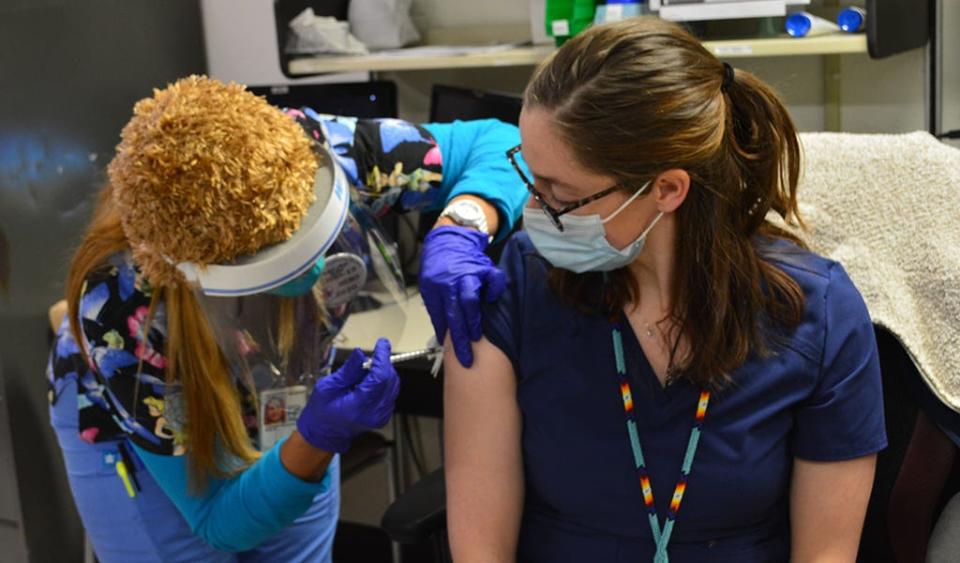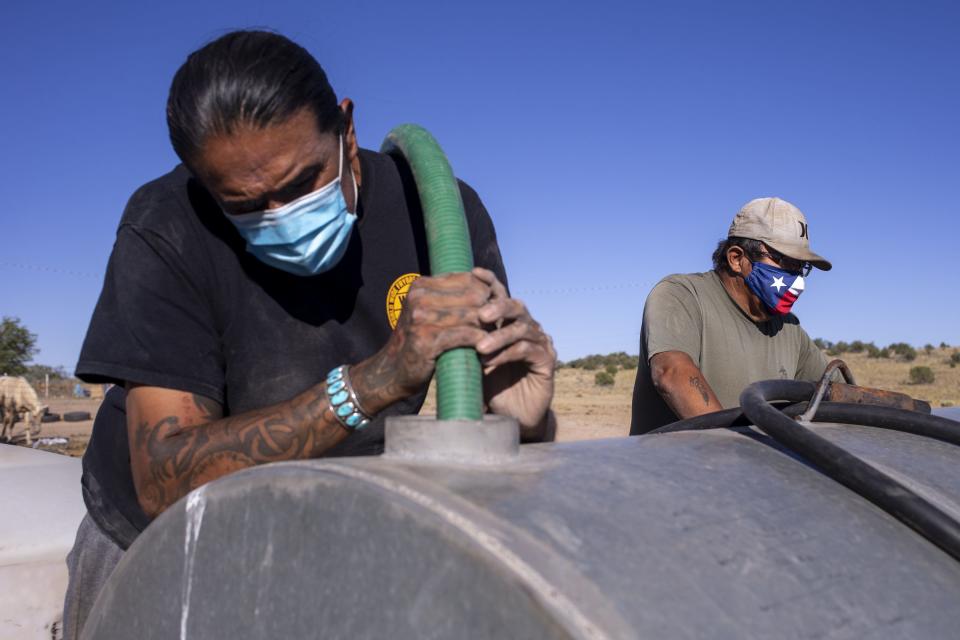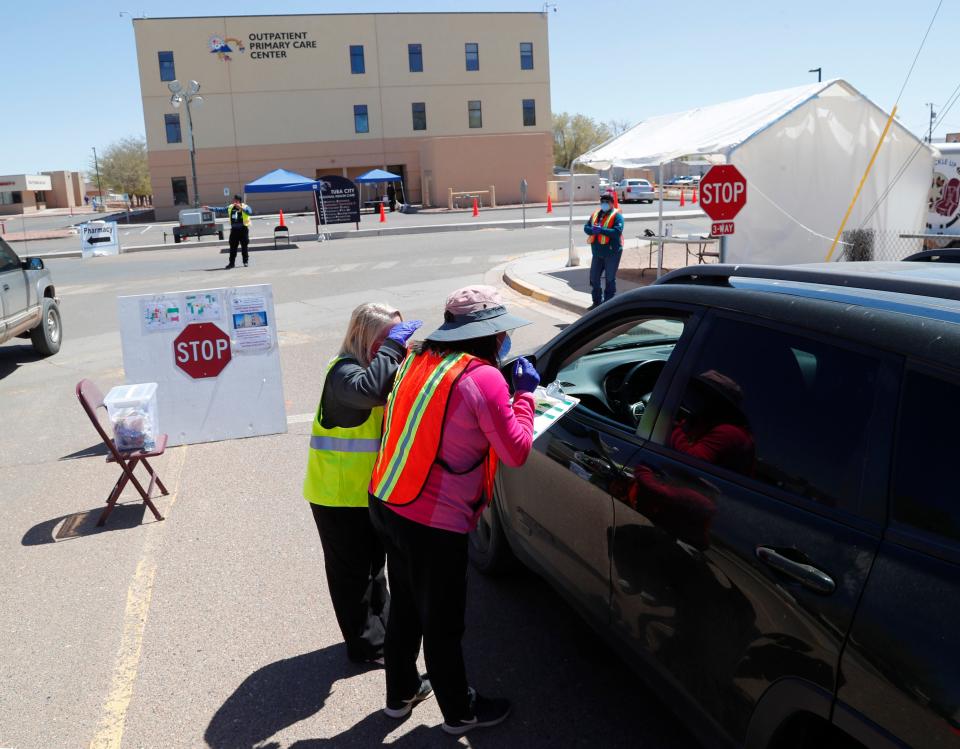Navajo Nation health centers deal with higher COVID-19 rates, water and staffing issues
Medical and health care facilities on the Navajo Nation, still reeling from the coronavirus pandemic, are seeing a steady rise in COVID-19, respiratory infections and syphilis cases, along with growing worker vacancies and infrastructure in need of improvement, according to a series of recent reports.
Health care and tribal officials are looking for ways to address not only the health concerns of communities, where the pandemic took a heavy toll, but also issues as basic as access to water.
It’s been a year since Navajo Nation leadership lifted mask mandates and halted weekly updates on COVID-19, variants, and respiratory infections. According to the monthly status report of the ongoing pandemic compiled by the Navajo Epidemology Center, since the start of the pandemic in March 2020 to December 31, 2023, there have been 2,248 deaths due to COVID-19 and 88,575 total cases. From November to December 2023, there were 463 new cases reported.
The Chinle Service Unit Emergency Department late last year reported a steady increase in the daily number of visits for respiratory infection symptoms, and the Division of Public Health was seeing an increase in COVID cases, but not COVID hospitalizations, across the service unit, according a Navajo Area Indian Health Service quarterly report in October.
“In order to mitigate the adverse effects of this respiratory infection season, the nursing, clinical, pharmacy, and public health divisions collaborated to update procedures for ensuring eligible patients are treated for COVID infections within 24 hours of diagnosis, even when they are diagnosed by a home test over the weekend,” the report said.
In a report issued three months later, in January, the Chinle Service Unit noted an increase in the number of patients visiting the emergency department who required transfer to another facility. The report did not specify whether these transfers were related to COVID-19.

“Since early 2021, regional hospitals have had markedly reduced capacity to accept transfers largely due to staffing shortage,” the report said. “Resources such as ambulances, helicopters and airplanes are stretched thin.”
In the eastern part of the Navajo Nation, the Crownpoint Service Unit reported in October a 40% increase of COVID-19 positivity rate, which led to the re-implementation of mask wearing. In the three months since then, 15 communities within the service unit held a COVID-19 and flu vaccination event, where 1,645 people received their vaccines.
Syphilis cases are on the rise
The Navajo Area Indian Health Center has also seen an uptick in syphilis cases. This increase has also been reported throughout the country by the U.S. Department of Health and Human Services. In its study, the federal agency said syphilis cases have reached the highest levels since the 1950s.
According to a Centers for Disease Control and Prevention report published Thursday, 207,255 total syphilis cases were reported in the United States in 2022, representing an 80% increase since 2018 and continuing a decades-long upward trend. Cases in nearly every demographic group and region increased, as did disparities in the burden of disease among certain racial and ethnic populations.
According to the report, more than 3,700 cases of congenital syphilis were documented among newborns in 2022, more than 10 times the number diagnosed in 2012.
“The Navajo Area Public Health Division is working with federal service units to develop an area-wide framework for conducting surveillance and evaluating response efforts,” the Navajo Area IHS said. “Developing a formal surveillance system has proven challenging due to the clinical expertise required to distinguish primary, secondary, and latent syphilis cases.”

Navajo Area IHS said its priorities will be to improve coordination of case management between sites, and collaborate with IHS headquarters to improve testing and treatment.
Water resources are stretched thin
Amid the concerns about infection rates, water access remains a significant issue on the Navajo Nation, challenges that were reflected in the Diné Household Water Survey Project, a survey of 900 people conducted with partners at John Hopkins University.
The Navajo Nation Council voted down legislation to allocate $1.3 million for a water extension line in the Kin Dah Lichii community. Lawmakers opposed the allocation, arguing that the funds should be drawn from the annual $120 million received by the Navajo Area Indian Health Service through the Infrastructure Investment and Jobs Act, rather than using internal tribal funds.
The bill's sponsor expressed the intention to eventually connect the extension with water from the Navajo-Gallup Water Supply Project. The ultimate goal is to enable the flow of water throughout the western Navajo Nation, including Dilkon.
The Dilkon Medical Center struggled to open on time due to the lack of water. Virgil L. Davis, acting chief executive officer for Dilkon Medical Center, said he appreciated the water they were able to get so far, but they are need to secure additional water capacity as the community of Dilkon grows.
“Right now minimum operational water is coming from Lower Greasewood wells and treatment plant,” Rex P. Kontz, Navajo Tribal Utility Authority’s deputy general manager, told The Republic.

Getting water to the medical center was no walk in the park, Kontz said, and from the beginning NTUA warned that its system did not have the requested capacity needed.
“Exploration of groundwater in the area has historically provided any additional water,” said Kontz. “That’s why the C-aquifer in Leupp was targeted.”
When it became evident that the progress in designing and constructing the water supply system for the facility was lagging behind schedule, NTUA was approached to assist with the water-related challenges.
At the time, NTUA was installing a water treatment plant to address issues related to heavy iron and manganese, aiming to significantly enhance water quality as well as improving its well field in Lower Greasewood, said Kontz. While these initiatives led to a modest improvement in water production, the enhancement was not substantial.
“We negotiated a minimum amount we could supply to meet requirements to open up the hospital,” said Kontz. “ It also required an upsizing of a section of line for higher volume of flow, and a new booster station to increase the ability to flow toward Dilkon. All our projects were quickly designed, released, constructed and met all agreed to deadlines.”
Dilkon Medical Center needed 41,347 gallons per day, and NTUA committed to a minimum of 21,600 gallons per day due to current system capacity. More water is needed and will be provided when the Leupp-to-Dilkon line is completed, after which the hospital can open at full operation, including other functions and housing, said Kontz.
“The Leupp-to-Dilkon line is supposed to make up the additional 20,000 gallons per day,” said Kontz. “It is supposed to provide the total 41,347 and free up the 21,600 we’re supplying to the rest of the communities from Lower Greasewood to Dilkon.”
Staffing vacancies remain at health care facilities
At the Dzilth-Na-O-Dith-Hle Health Center 30 miles south of Bloomfield, New Mexico, a shortage of providers has been a challenge.
“The shortage of physicians to serve in rural and underserved communities can be challenging for a community because it can delay quality clinical services,” according to the Navajo Area IHS report.
In October and November, Four Corners Regional Health Center assigned a provider to work at the rural health center four days a week to provide care.
The lasting effects of the pandemic are still felt in staffing levels at the new Dilkon Medical Center, where there is a shortage of nurses.
Peter Laluk, acting chief executive officer and director of quality management for Winslow Indian Health Care Center, said after pandemic-related burnout, facilities have been having a hard time recruiting nurses.
“I will tell you from looking historically, nursing is our biggest area,” said Laluk, who also oversees Dilkon Medical Center. “So if you know any nurses, we’re hiring.”
Navajo Epidemology, Navajo Area Indian Health Service, and Indian Health Service headquarters did not respond to requests made for comments.
Arlyssa Becenti covers Indigenous affairs for The Arizona Republic and azcentral. Send ideas and tips to arlyssa.becenti@arizonarepublic.com.
This article originally appeared on Arizona Republic: Navajo health centers see a rise in COVID-19, syphilis infections

